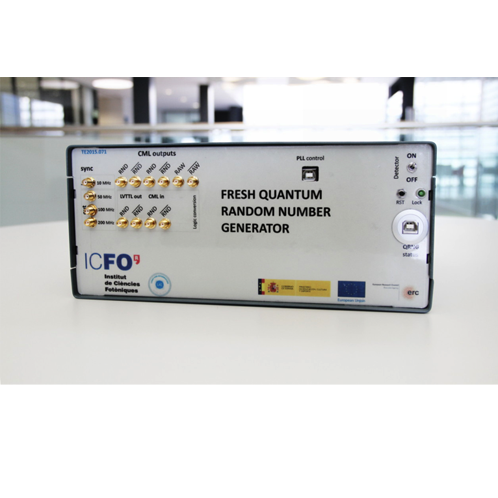Artistic
Impression of the Entanglement of electrons
(October 22, 2015) Historic
Delft Experiment tests Einstein’s “God does not play dice” using quantum “dice”
made in Barcelona
Random number generators developed at ICFO – The Institute
of Photonic Sciences, by the groups of ICREA Professors Morgan W. Mitchell and
Valerio Pruneri, played a critical role in the historic experiment was
published online today in Nature by the group of Ronald Hanson at TU Delft. The
experiment gives the strongest refutation to date of Albert Einstein’s
principle of “local realism,” which says that the universe obeys laws, not
chance, and that there is no communication faster than light.
As described in Hanson’s group web the Delft experiment
first “entangled” two electrons trapped inside two different diamond crystals,
and then measured the electrons’ orientations. In quantum theory entanglement
is powerful and mysterious: mathematically the two electrons are described by a
single “wave-function” that only specifies whether they agree or disagree, not
which direction either spin points. In a mathematical sense, they lose their
identities. “Local realism” attempts to explain the same phenomena with less
mystery, saying that the particles must be pointing somewhere, we just don’t
know their directions until we measure them.
When measured, the Delft electrons did indeed appear
individually random while agreeing very well. So well, in fact, that they
cannot have had pre-existing orientations, as realism claims. This behaviour is
only possible if the electrons communicate with each other, something that is
very surprising for electrons trapped in different crystals. But here’s the
amazing part: in the Delft experiment, the diamonds were in different
buildings, 1.3 km away from each other. Moreover, the measurements were made so
quickly that there wasn’t time for the electrons to communicate, not even with
signals traveling at the speed of light. This puts “local realism” in a very
tight spot: if the electron orientations are real, the electrons must have
communicated. But if they communicated, they must have done so faster than the
speed of light. There’s no way out, and local realism is disproven. Either God
does play “dice” with the universe, or electron spins can talk to each other
faster than the speed of light.
Fastest Quantum
Random Number Generator
This amazing experiment called for extremely fast,
unpredictable decisions about how to measure the electron orientations. If the
measurements had been predictable, the electrons could have agreed in advance
which way to point, simulating communications where there wasn’t really any, a
gap in the experimental proof known as a “loophole.” To close this loophole,
the Delft team turned to ICFO, who hold the record for the fastest quantum
random number generators. ICFO designed a pair of “quantum dice” for the
experiment: a special version of their patented random number generation
technology, including very fast “randomness extraction” electronics. This
produced one extremely pure random bit for each measurement made in the Delft
experiment. The bits were produced in about 100 ns, the time it takes light to
travel just 30 meters, not nearly enough time for the electrons to communicate.
“Delft asked us to go beyond the state of the art in random number generation.
Never before has an experiment required such good random numbers in such a
short time.” Says Carlos Abellán, a PhD student at ICFO and a co-author of the
Delft study.


